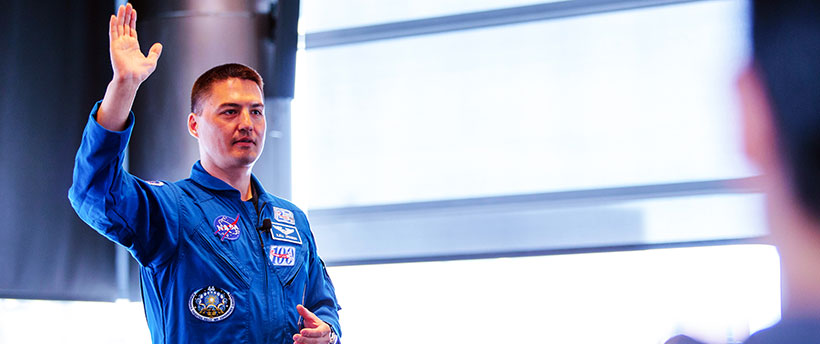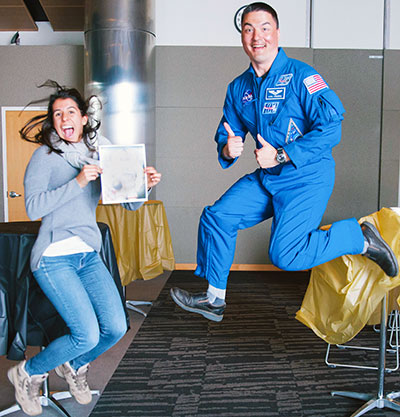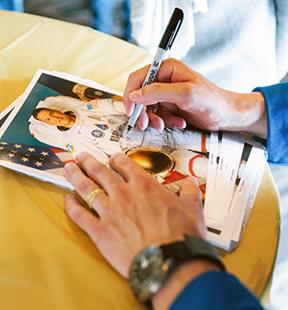The Death of My Patient Last Week
Student Voice

By Steven Barcus
(May 2016) Kjell Lindgren, MD ’02, has wanted to be an astronaut as long as he can remember. That dream became a reality in July 2015 when he blasted off from Kazakhstan in July as part of NASA’s Expedition 44/Expedition 45 to the International Space Station (ISS). During his 141 day mission, Lindgren completed two
“That was one short amazing leg of a really extraordinary journey,” Lindgren told a group of students during a visit to CU Anschutz in March. “I spent a good deal of my journey at CU. That journey took me to NASA for two and a half years of training to be an astronaut, with two years of
Changing the map
Lindgren’s journey to space has been decades in the making.
Fascinated with space, Lindgren had read “The Right Stuff” and Chuck Yeager’s biography — using those books to create a map he could use to become an astronaut. That map told him he needed to become a test pilot. At age 11 he sent off for materials to apply for the Air Force Academy. He never got a response, but that did not deter Lindgren from his dream.
Lindgren continued to follow his map. He was eventually accepted into the Air Force Academy and was awarded a pilot slot, which Lindgren deferred to study at Colorado State University. After returning for pilot training, Lindgren, who describes his journey in terms of peaks and valleys, was diagnosed with a medical condition that not only washed him out of pilot
“That was
Lindgren’s new map brought him to the University of Colorado, where he earned his MD in 2002.
“I had the great fortune to study here at CU,” Lindgren said. “I am profoundly grateful to be back on the CU campus. This is where I did my medical training. It was a significant and very important part of my career. It feels like I am coming full circle to be back here today talking about this incredible journey.”
Time at CU
 Lindgren spoke with students about his own experience at CU, recalling long nights memorizing the names of bones, muscles
Lindgren spoke with students about his own experience at CU, recalling long nights memorizing the names of bones, muscles
“Whatever you’re doing you have to be a nerd in it, so we became anatomy nerds,” Lindgren said. “You have to bring it.”
It was not just Lindgren’s incredible work ethic that saw him through his medical training. He also employed outside-the-box methods to succeed. To ensure he would do well on a test identifying
The work yet again paid off. Lindgren’s unorthodox test preparation showed that the thoracic duct appeared on most of the practicals. During the test, when he saw a pin placed in an unknown area of the cadaver, he made the assumption that it must be the thoracic duct. He was right.
“Work hard and enjoy your life along the way,” Lindgren said. “I’m grateful for my path. Even though I slipped into several valleys I was always able to climb my way out.”
Lindgren went on to become board certified in emergency medicine and aerospace
 ‘An indescribable experience’
‘An indescribable experience’
While Lindgren’s medical training helped him stand out among other applicants, his primary role during the mission was not as a physician. According to Lindgren, a physician is not always included on every flight
as all astronauts are trained across all equipment, duties
“Whether you are a test pilot, infectious disease researcher or a physician, we all get trained the same level on all of the equipment,” Lindgren said. “We can all repair equipment, do a spacewalk and respond to emergencies.”
Lindgren assisted in a variety of studies while aboard the ISS. Some of the research conducted included understanding how flames propagate and how fuel moves within a tank in space. He and his fellow astronauts also grew and ate lettuce—becoming the first astronauts to grow and consume a crop in space.
Perhaps the most significant moments for Lindgren were spent during his two spacewalks, each of which lasted more than seven hours.
Achieving his dream of becoming an astronaut has not left Lindgren without purpose. Since returning to Earth, he has been speaking with the public about his experiences in space and is looking forward to analyzing data from his experiments in space and helping to train the next group of astronauts. Lindgren is open to a return trip to the ISS, but in the meantime is enjoying discussing his journey.
“There is no one path to becoming an astronaut,” Lindgren said. “That’s demonstrated in my career. Find a place where you are passionate and work to get to the top of your field. If you study what you think NASA wants you to study and you don’t like it, you won’t succeed. Choose what you have a passion for.”